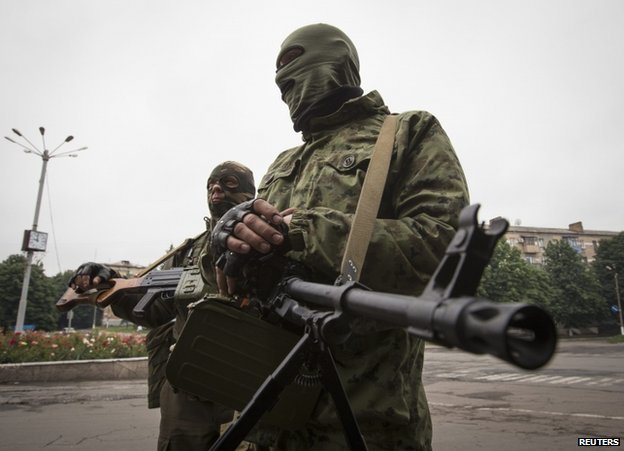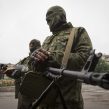
Moscow’s Dilemma: Finlandization of Ukraine or Occupation?
Publication: Eurasia Daily Monitor Volume: 11 Issue: 106
By:

Russia seems at a crossroads in the Ukrainian crisis, unsure how to proceed: to seek some negotiated compromise with Kyiv, or intensify its support for pro-Russian separatists in southeastern Ukraine? During Russian Foreign Minister Sergei Lavrov’s visit to Finland last week, a possibility was discussed that Ukraine might follow Cold War–era Finland in what was then known as “Finlandization”—that is, building a neutral democratic nation with a market economy, but politically under Moscow’s thumb. According to Lavrov, “We have many times proposed that all of us—Europeans and Ukrainians—come together and find a way to avoid forcing Ukraine to tear itself apart between right and left.” Since last year, Moscow was been pressing Brussels to start tri-party talks to decide Ukraine’s future status. The idea was flatly rejected by the European Union and by the Ukrainian leaders that emerged after the fall of former president Viktor Yanukovych (RIA Novosti, June 10).
After the annexation of Crimea last March and the de facto secession of parts of Donetsk and Lugansk regions that have proclaimed “independent people’s republics” last month, the Kremlin wants a decisive say in the future of rump Ukraine. Today, Moscow is acting as it did in other post-Soviet conflicts—in Transnistria in Moldova, in Abkhazia and South Ossetia in Georgia, and in Karabakh in Azerbaijan. Specifically, Russia is trying to covertly fan internal separatist armed conflicts and later act as a possible intermediary or peacekeeper. Such “frozen conflicts” tend to stay unsettled for decades, giving Moscow excellent leverage to control both the separatist self-proclaimed republics and the internationally recognized rump nations from which they seceded. This week (June 12), Lavrov told journalists: “The stage has not been reached yet for us to consider sending in peacekeeping forces, since there is hope President [Petro] Poroshenko [elected on May 25] will make good on his promise to stop armed violence, and talks will begin.” Lavrov added, “We know the volunteer self-defense forces in the southeast are ready for a ceasefire, but the authorities in Kyiv must make the first step after the [June 7] inauguration of Poroshenko” (Interfax, June 12).
Lavrov had previously acknowledged that Russia was sending the armed separatists “humanitarian aid” directly over the Russian-Ukrainian border, large spans of which in Donetsk and Luhansk regions have been abandoned by Ukrainian officials and border guards (ITAR-TASS, June 11). Kyiv has strongly protested Russian actions that apparently violate a 1994 border agreement under which Russia must close border crossings on its side of the border after Ukrainian border guards close their posts—which Russia has not done. Moscow acknowledges it allows refugees to flee the fighting in Donbas and Luhansk, while allowing “humanitarian aid” to be delivered to rebels that have come across the border. Kyiv alleges volunteer fighters are being moved into Ukraine together with weapons, munitions and money to keep the insurgency on track. After a short face-to-face meeting with Poroshenko in France during the D-Day commemoration celebrations on June 6, Vladimir Putin reportedly ordered the Federal Security Service (FSB) “to reinforce security on the Russian-Ukrainian border to prevent unauthorized crossings.” This week, the Ukrainian Foreign Ministry accused Putin of doing nothing to back up this declaration with concrete action (rus.newsru.ua, June 11).
The pattern of Russian actions closely follows similar activities in Abkhazia and South Ossetia from 1991 to 2008, when men and weapons were constantly covertly moved through border crossings jointly controlled by pro-Russian separatists and Russian border guards. Denis Pushilin—the chairman of the self-proclaimed “Supreme Soviet of the Donetsk People’s Republic” (Donetskaya Narodnaya Respublika—DNR)—arrived in Moscow this week, apparently using one of the corridors across the Russian-Ukrainian border controlled by the separatists. Pushilin met Russian State Duma deputies, spoke at an officially approved pro-separatist rally in central Moscow and told reporters: “The DNR is ready to speak with Kyiv only with Moscow acting as an intermediary.” According to Pushilin, the rebels want to exchange prisoners of war, “discuss the withdrawal of illegal [Ukrainian government] forces from the region,” and establish a “humanitarian corridor” to Russia. A united Ukraine “is now a dream,” according to Pushilin, but he acknowledged the separatists “are barely holding their ground” and begged for the deployment of Russian peacekeepers (RIA Novosti, June 11).
The transition from Russia’s direct military intervention in and later annexation of Crimea to Moscow’s covert support of the armed rebellions in Donetsk and Luhansk has been interpreted by former Kremlin insider Gleb Pavlovsky (ng.ru, June 7) and former prime minister Mikhail Kasyanov (news.liga.net, June 7) as a genuine de-escalation by Putin, who was thwarted by Western threats and sanction. According to Pavlovsky and Kasyanov, the Russian president is, at present, trying to save face by different propaganda means. Whereas, the two men argue, Putin’s grand idea of carving out a “Novorossiya” or “New Russia” out of Russian-speaking Ukrainian regions from Kharkiv in the northeast to Odessa in the south has been, in essence, abandoned. This is clearly not so: On June 12, apparently several tanks and other armored vehicles appeared in the Ukrainian town of Snehznoye in the Donetsk region. According to Ukrainian Interior Minister Arsen Avakov, these tanks came over the border from Russia to support the rebels (news.liga.net, June 12).
This week in Moscow, Putin’s economic advisor in charge of the Ukrainian situation Sergei Glazyev told journalists: “Time is on the side of the Nazis [referring to the authorities in Kyiv, including Poroshenko].” The “Kyiv Nazis,” according to Glazyev, armed, financed and directed by Washington, are swiftly building up a formidable war machine: “In February, they had 20,000 armed men, by September they may have 200,000.” Glazyev argued that armed action must be taken before the pro-Russian separatists are defeated and Moscow is facing a hostile army ready to invade and “liberate” Crimea. Glazyev advocated an imposition of a no-fly zone over Ukraine, while the Russian air force may knock out Ukrainian armor “like the Americans [did] in Libya” (pravda.ru, June 10). Glazyev may have been expressing his personal opinion, but his assertions are clearly part of the present Kremlin-insider discourse—notably, he was not publicly reprimanded for his remarks, or ousted as an advisor. The Kremlin does not seem ready to allow the collapse of the armed separatist rebellion in Donetsk and Luhansk no matter what it takes: If increased covert support, including with tanks and armed volunteers, fails to press Kyiv into allowing the conflict to transform into a “frozen” institutionalized secession, more drastic moves are possible.




